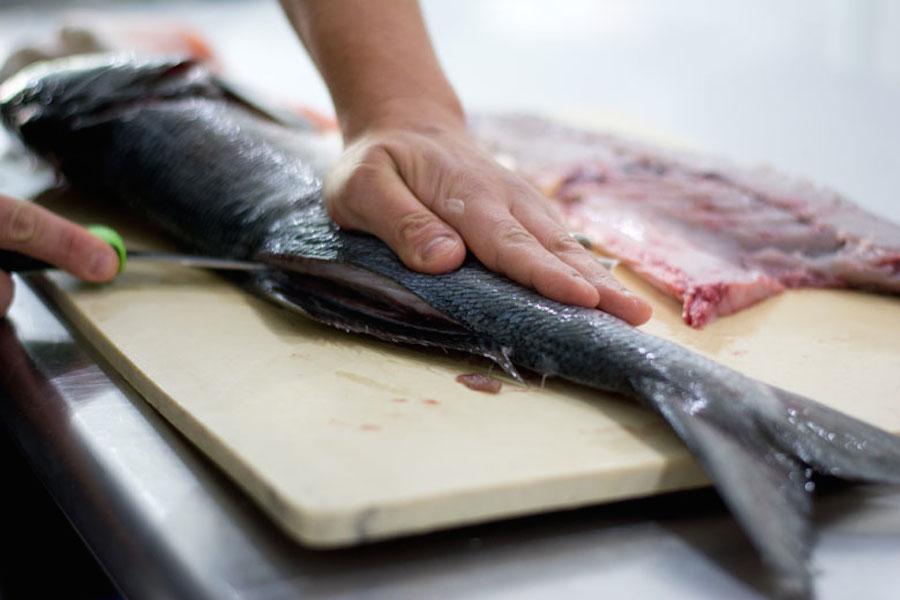We can’t all build an A-frame to roast a whole hog in Brooklyn, but when it comes to going head-to-tail, fish might just be the easiest beast to deal with. Best case scenario, find a fish small enough to steam, large enough to share.
But of course, fishes come in all shapes and sizes, and the most delicious ones — bluefish, halibut, salmon — are hefty creatures. And since we all can’t stuff a giant fish on giant grill, we headed over to Mermaid’s Garden in Prospect Heights where Mark Usewicz showed us how to clean and breakdown a fish, and what to do with every single part.
To choose the best fish:
There are four signs to a perfect fish: Clear eyes, bright red gills, a firm body (it should still be in rigor mortus), and plenty of slime (but no smell).


The tools:
- Japanese fish scalers (Urokotori): Find one for larger scales (1) and one for smaller scales (2). They’re more delicate on the fish, Usewicz says, and beats using the back of your knife, which can batter the meat.
- Filet knife: A traditional filet knife (1), with a curved blade, is a basic utilitarian knife. “It’s a pretty stiff blade, and it’s good for cutting meat and getting into the bones,” Usewicz says. If you want to get fancy, opt for a Japanese knife instead (2), which is a different style but equally useful. “It’s mostly whatever you’re comfortable with.” Consider a thinner, flexible curved knife (3) for slicing skin off the fish.
To clean:
First things first, scale the fish. “If I were at home and scaling, I would get a big plastic bag and put the fish inside of it,” Usewicz says. Even better, do it outside. “Scales are a nuisance,” he says. “They get everywhere, they stick to everything. I’ll find them stuck to me hours after leaving here and showering.”
Scales run towards to the tail, so scale against them, starting from the tail to the head. “You really want to make sure you get behind the fins, along all the edges,” Usewicz says. “People tend to miss those spots.” Flip the fish over, repeat and rinse off the fish, checking one last time with your hands. “Scales are often missed right behind the dorsal fin, and right along it, generally anywhere the fish curves,” Usewicz says. “It’s important to make sure you don’t have scales there because that’s where you’re going to make the knife cut.”
Next, you want to take out all the organs, lest you puncture one during filleting and get bile everywhere. Make a shallow incision starting from the anus to the head, without hitting any of the internal organs. “There’s really no pretty way to do it,” Usewicz says, as he pulls all the organs out and rinses the fish. Toss the organs; “I don’t eat organ meat from the fish because that’s where a lot of mercury accumulates,” he says.
The filets (see slideshow above):
Start with the belly facing away from you, the dorsal fin facing you. Make a cut right behind the collar right above the fin, with the blade facing you. “You want the knife turned towards the head a little, too, because there’s some meat down there,” Usewicz says.
Next, turn the blade so it is facing away from you, and follow the shape of the bone through until you separate the meat from the collar.
Find the bone along the dorsal fin, and starting at the head, hold your knife against it, cutting lengthwise all the way down the length of the fish. “I just do long strokes, no sawing motions because that will damage the meat,” Usewicz says. “That’s why the curve on the knife is nice, so you can get the blade to do most of the work.”
Flip over the fish and repeat. “The second filet can be trickier because it’s not flat, so start in the middle,” Usewicz suggests. Pro-tip: As you get deeper into the fish, hold your knife next to the skeleton, applying just a little pressure, and allow the weight of the filet to help separate the meat from the bones. You want your knife to be sharp for this.
Finally, debone the filets using pliers, or simply cut away the bones in a sharp “V.”
To cook: The filet is the easiest part of the fish to cook. “Anything goes,” Usewicz says. “Pan fry them, broil them, bake them with just a little salt and pepper.” Add a squeeze of lemon at the end, right before serving.
The collar:
Grab a hefty pair of kitchen scissors and find where the collar meats the head at the bottom of the fish. Snip there.
Then, find where the collar connects on the top, behind the operculum, which covers the gills. Snip there. Flip the fish over and repeat.
To cook: “The collars are really good broiled or just grilled,” Usewicz says. Choice fish for collar meat: striped bass, black sea bass, salmon, tilefish, and tuna (although the last is rather hefty).
The head:
If you’re planning on using the head separate from the rest of the skeleton, grab a cleaver. “It’s good if you need to take out some anger, you can just hack the head away,” Usewicz says. A less angry option? Just get a sharp knife and cut between the vertebrae.
Then, remove the gills with a pair of kitchen scissors, since they might affect the flavor. Same with the eyes if you’re being thorough.
To cook: The head, which still has plenty of meat, adds depth to stock and sauces. For a sauce, simmer the head for an hour or two in your favorite tomato sauce. “It’s a delicious, meaty sauce, but if you’re a squeamish fish eater it might not be the best thing,” Usewicz says. “You’re going to be picking up bones and eyeballs.”
To make a stock, place the fish head in cold water, just enough to barely cover the fish. Toss in simple vegetables like celery, onion, fennel tops, ginger, and a couple bay leaves. Bring the pot of water up to a simmer, simmer for 30 minutes, and strain it. “In the restaurants we would soak the fish heads for a day in cold water,” Usewicz says, “but that’s a bit much.”
The cheeks:
Feel along the eye to find where the bone ends; that’s where the cheeks are. Cut along the bone, following the circular, conical shape until the entire cheek is removed. Slice the skin off.
To cook: Pan-frying is the easiest way to deal with these little nuggets. “There’s a lot of gelatin in them, which makes them break down and get really delicious, so just pan-fry them with some salt and pepper,” Usewicz says. Opt for grouper or halibut cheeks.
Everything else:
No matter how great a fish filleter you are, there will always be some extra meat left on the skeleton. Grab a spoon and scrape the remaining meat off the bones; use this for tartare. Then, use the bones and tail for stock (see above for instructions).













